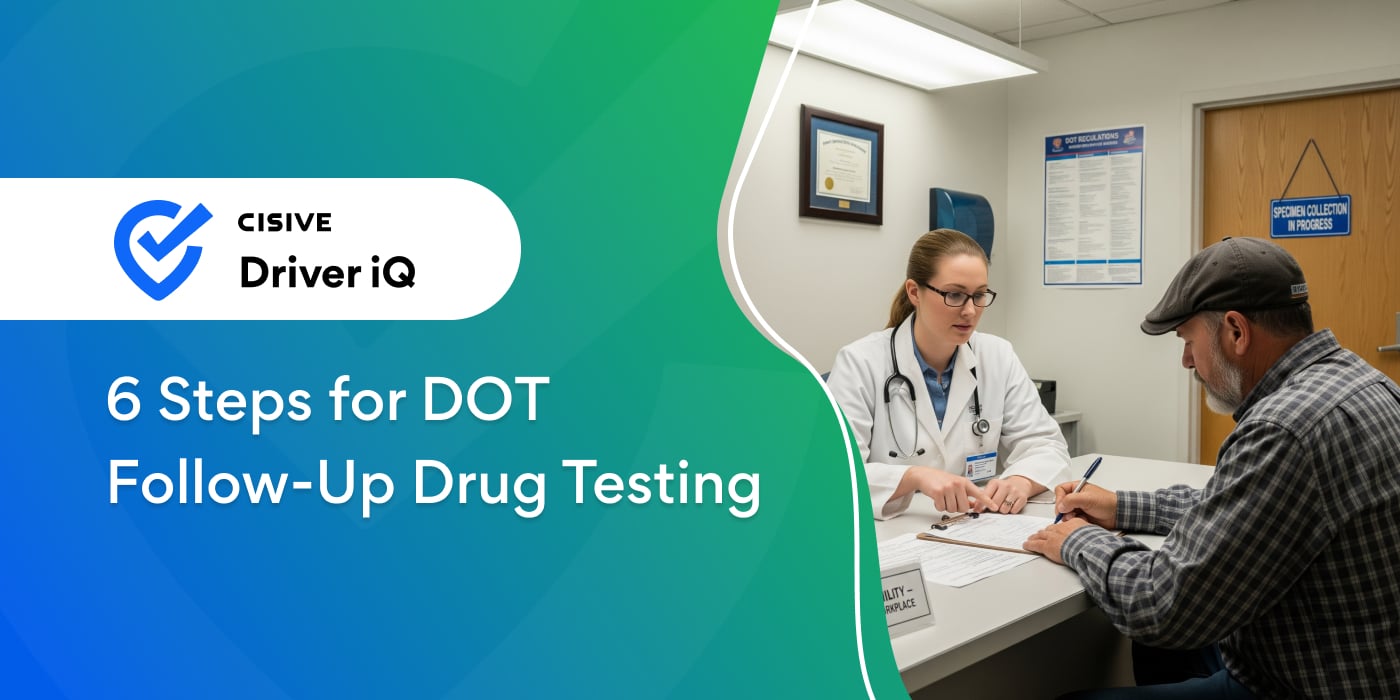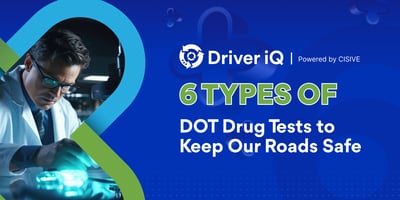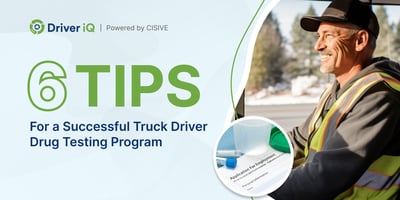

If you employ commercial drivers, your company is responsible for maintaining a formal drug testing...

When drivers fail a DOT-mandated drug or alcohol test or refuse to take one, they create business-critical liabilities for their employers. This scenario triggers a high-stakes compliance process governed by strict federal regulations. Mismanaging it can put your company at risk of fines, lawsuits, and accidents, all while damaging your brand.
Understanding DOT follow-up drug testing procedures isn’t just a legal requirement. It’s also one of the best ways to protect your company. When you know how and when to conduct follow-up tests, you’ll stay in compliance while safeguarding your fleet, business reputation, and bottom line.
In this guide, we'll walk you through every stage of the process and show you how Driver iQ helps simplify the steps so you can focus on managing your workforce safely and efficiently.
Key TakeawaysHere are the key things you need to know about DOT follow-up drug testing procedures:
|
DOT follow-up drug testing is a federally mandated process required for safety-sensitive employees who have violated drug or alcohol regulations. After completing the return-to-duty test, these employees must undergo a series of unannounced follow-up tests, as directed by a DOT-qualified substance abuse professional (SAP). The plan typically includes at least six directly observed tests within the first 12 months, with up to five years of additional testing.
This program is critical to maintaining workplace safety and regulatory compliance. Employers are responsible for implementing the follow-up plan, but doing so can be complex without the right tools. Solutions like Driver iQ's FMCSA Clearinghouse integration and continuous monitoring services help streamline compliance and reduce the risk of oversight.
DOT follow-up drug testing involves a structured series of drug and alcohol tests designed to monitor drivers who are returning to safety-sensitive duties after a violation. The testing is directly observed and cannot be predicted by the employee.
The process typically includes:
A minimum of six unannounced tests in the first 12 months following a return to duty
Direct observation for every follow-up test to ensure integrity
Testing that may extend up to 60 months, depending on the SAP’s recommendation
Coordination and implementation responsibilities that fall solely on the employer
Documentation and recordkeeping requirements to remain compliant with DOT regulations
DOT follow-up drug testing is initiated after an employee completes a return-to-duty drug test under the guidance of a DOT-qualified SAP. The SAP plays a central role by evaluating the employee, recommending treatment or education, and creating a tailored follow-up testing plan. The employer is responsible for implementing the plan, which includes unannounced, directly observed tests to monitor compliance over a specified length of time.
Key elements of the process include:
An initial evaluation and treatment recommendation by a certified SAP
A return-to-duty test that must be passed before safety-sensitive duties can resume
A written follow-up testing schedule developed by the SAP
A minimum of six directly observed tests in the first 12 months
Ongoing testing (for up to 60 months) based on SAP guidance
The employer’s responsibility for administering and documenting follow-up tests
DOT follow-up drug testing is required for safety-sensitive transportation employees who have violated federal drug and alcohol testing regulations. This includes employees who refuse to take a DOT drug or alcohol test, not just those who fail such a test. These individuals can’t return to duty until they complete the return-to-duty process, which includes evaluation by a DOT-qualified SAP, a successful return-to-duty test, and enrollment in a follow-up testing program.
This requirement applies across various transportation roles, including:
Commercial truck and bus drivers
Train engineers and conductors
Pilots and aviation personnel
Subway and transit operators
Ship captains and crew
Pipeline emergency response workers
The follow-up testing process is non-negotiable. It applies to violations across test types, including pre-employment, random, post-accident, or reasonable suspicion testing. Employers are responsible for ensuring that the employee completes all SAP-recommended follow-up tests while performing (or returning to) safety-sensitive functions.

Managing DOT follow-up drug testing requires a detailed understanding of each step involved. Employers are responsible for initiating the return-to-duty process and carrying out the follow-up testing plan developed by the SAP.
The steps below outline what happens, from the initial test failure through long-term monitoring. Follow these steps to protect your organization, maintain compliance, and ensure only qualified drivers are behind the wheel.
As an employer, you are legally obligated to take swift action when an employee fails a DOT drug or alcohol test or refuses to take one. This includes drivers who fail or refuse tests required under 49 CFR Part 40. Such employees must be immediately removed from safety-sensitive duties.
This step ensures your organization stays compliant, reduces liability risk, and protects public safety. For example, if a driver refuses a random test, continues driving, and gets into an accident, your company could face steep liability and reputational damage.
Following the test failure or refusal, employers must refer the employee to a DOT-qualified SAP. This referral is mandatory and must be documented. The employer’s role includes making a prompt referral and briefing the employee on their next steps. Failure to do so can delay recovery and increase business risk.
The SAP conducts a comprehensive clinical assessment to understand the severity of the substance use issue. Based on this evaluation, they recommend an education or treatment program tailored to the employee’s needs.
Employers are not involved in the treatment but should stay in contact with the SAP for documentation purposes. For instance, if a driver is required to complete a six-week outpatient program, the SAP will verify completion before approving further steps.
After the employee completes the recommended program, they return to the SAP for a follow-up evaluation. If the SAP determines the employee has successfully complied, they will authorize a return-to-duty drug test and provide a written follow-up testing plan.
This plan outlines the number, frequency, and duration of unannounced drug and/or alcohol tests required.
The SAP will provide the written plan to the employer, who must retain this documentation and prepare to implement the plan exactly as written. Employers are fully responsible for scheduling and documenting all required tests. The plan may involve at least six unannounced tests in the first 12 months, with additional testing for up to 60 months. These tests must be conducted under direct observation.
Employers should treat this testing plan as a compliance checklist. Missing even a single test could lead to federal violations and increased liability. Consider using tools like Driver iQ to track and execute these plans reliably.
Every follow-up test must be administered under direct observation, per DOT rules. This means a trained observer must watch the sample-collection process to prevent tampering. The SAP determines how many tests are required and in what time frame.
During this period, employers must maintain oversight and document each test to prove ongoing compliance. For example, a driver who refused a DOT alcohol or drug test might be subject to random quarterly tests for three years. In this case, each test must be carried out without prior notice and thoroughly documented.
Failing to conduct follow-up drug testing can have serious legal, financial, and reputational consequences. Employers that allow non-compliant drivers to return to duty without proper oversight are violating DOT regulations, which can result in fines, audit failures, or disqualification from operating. Beyond regulatory penalties, the cost of an incident involving an untested driver can expose your company to lawsuits and irreparable brand damage.
Real-world cases have shown that even a single missed test can lead to multimillion-dollar liability claims. In an industry where one poor decision behind the wheel can cost lives, ignoring follow-up testing protocols shows negligence. Additionally, failure to conduct or document follow-up testing can hinder applicant screening processes for other employers.
DOT compliance isn’t a one-time event. It’s an ongoing commitment to safety and accountability.
Driver iQ, a Cisive company, helps fleet employers reduce compliance risks and simplify the complex follow-up testing process. With built-in support for FMCSA Clearinghouse integration, employment verification, and continuous driver monitoring, Driver iQ ensures that no required step falls through the cracks. The platform is designed specifically for the transportation industry, so you can automate testing reminders, maintain accurate records, and ensure DOT-aligned testing schedules, all without manual tracking.
Driver iQ is your partner in risk mitigation. By streamlining everything from initial test failures to follow-up evaluations and long-term monitoring, Driver iQ gives your compliance team confidence that your fleet meets the highest standards of safety and readiness.
Understanding and following DOT follow-up drug testing procedures is crucial for protecting your drivers, your business, and everyone who shares the road. From managing SAP referrals to tracking multi-year testing plans, every step counts. With Driver iQ, you gain a trusted compliance partner that makes these steps easier, faster, and more reliable.
Ready to simplify follow-up drug testing and protect your fleet? Talk to a Driver iQ expert today to schedule a demo or book a consultation.
Author: Jessica McDonald
Bio: Product Strategy and Development, Drug Testing and Occupational Health Subject Matter Expert at Cisive
Let's Connect on LinkedIn
If you employ commercial drivers, your company is responsible for maintaining a formal drug testing...

Secure and reliable transportation networks rely on commercial drivers who are fit for duty and...
%20-%20Blog%20Post-1.png?height=200&name=BLOG_%20Understanding%20DOT%E2%80%99s%20Preemployment%20Drug%20Testing%20Requirements%20(Refreshed)%20-%20Blog%20Post-1.png)
The Department of Transportation (DOT) has hundreds of regulations designed to keep motorists,...